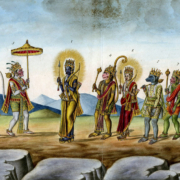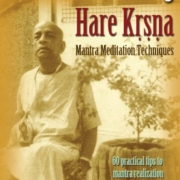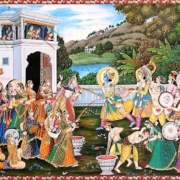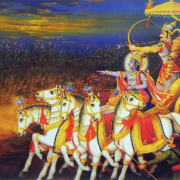Secrecy and the Mystic Mantra Science
By Mahanidhi Swami
Mantras give birth to sadhakas. Mantras sustain the lives of sadhakas, and mantras award spiritual perfection to sadhakas by giving darshana of their cherished ishta-devatas, Radha Govinda Yugala. In this article we will explore the details and varieties of various mantras.
Firstly, however, all sadhakas should know these four secrets. In Hari-bhakti-vilasa (2.146), Srila Sanatana Goswamipada commands fourfold secrecy for all sadhakas: they should not reveal their ishta-devata, initiating guru, their diksha mantra or japa-mala, gopayed devatam ishtam, gopayed gurum atmanah, gopayec ca nijam mantram, gopayen nija-malikam.
The Vedas mention three types of mantras: vedic, tantric, puranic. Each of these can be further divided into sattvic, rajasic, and tamasic mantras. Sattvic (mode of goodness) mantras are chanted for light, wisdom, divine love, compassion, and God realization.
Vedic Mantras have the power to destroy all karma, bring peace, give spiritual perfection, darshana of God, and liberation after death. Rajasic (mode of passion) mantras are chanted for progeny and material prosperity. Unlike sattvic mantras, which remove karma, rajasic mantras force men to take rebirth to reap the fruits of their karma. Tamasic mantras (mode of ignorance), popularly called tantric or “black magic,” are sinful. They are generally used to propitiate spirits, harm others, and perform vicious deeds.
The original spiritual letters are endowed with specific powers, and in particular combinations they assume more power in relation to certain Deities. These combinations of letters are called bijas or seeds, and they combine to form words. When these words are connected in a particular order, they have special powers to represent a Deity in full. These combinations are called mantras. The power then manifested in the whole mantra is greater than that of any of its constituent sounds.
The mantras, which are non-different from the Deity, are an eternal manifestation of the Deity and are spiritual by nature. By repetition of the mantra, the worshiper invokes the mercy of the Deity whose mantra he repeats. Chanting these mantras (i.e. pancaratrika Gayatri mantras) helps one realize the transcendental form of the Deities. The sadhaka thus overcomes illusion and regains his original spiritual position.
The mantra is an intrinsic form of the Lord. By the mercy of Guru and Vaisnavas, who are embodiments of Krishna’s mercy, Krishna enters the disciple’s heart in the form of mantra. The mantra, acts to cleanse the mind and heart of the disciple, and make him fit for serving the transcendent Lord.
There are six basic types of mantras used in Deity worship:
1) Dhyana Mantras—meditation mantras used to mentally invoke the Lord’s transcendental form, abode, and pastimes.
2) Bija Mantras—seed mantras for meditation and purification of articles used in puja.
3) Mula Mantras—root mantras, being the essence of the Deity, are recited along with each article of worship as a means of addressing the Lord.
4) Stutis & Stotras—prayers chanted before, during, or after worship to glorify the name, form, qualities, and pastimes of the Lord.
5) Pranama Mantas—prayers for offering obeisances to the Lord at the end of worship.
6) Gayatri Mantras—Vedic or Pancaratrika mantras used to worship the Lord, invoking the three principles of sambandha, abhidheya, prayojana.
The word Gayatri indicates a specific poetic meter (chandas) sung in Vedic hymns. Vedic mantras, such as Brahma-gayatri, are called sabda-brahma (eternal, spiritual [aprakrta] vibrations representing God in the form of sound). In summary, a mantra is a combination of particular energies in the form of sound, and its recitation evokes those energies externally and internally. Every mantra is a combination of specific letters, words, meanings, rhythms, and tunes.
There are four aspects of all bona fide Vedic and pancaratrika mantras:
1) Rsi or sage—is the medium or the means of communication between God and man through whom the mantra was given to mankind. Every mantra has a presiding rsi or saintly person who first heard the mantra in his meditation and subsequently spread it for the benefit of others. The Gayatri mantra, for example, was revealed to Visvamitra Muni after a transcendental experience in meditation, so he is accepted as the Rsi of the Brahma-gayatri mantra.
2) Chandas—is the poetic meter of a specific mantra such as Gayatri, Anustap, and Jagati. “The Vedic meters are Gayatri, Usnik, Anustup, Brhati, Parikti, Tristup, Jagati, Aticchanda, Atyasti, Atijagati and Ativirat. The Gayatri meter has twenty-four syllables, the Usnik twenty-eight, the Anustup thirty-two, and so on, each meter having four more syllables than the previous one. Vedic sound is called brhati, or most expansive, and thus it is not possible for ordinary living entities to understand all the technical details in this matter.” (SB 11.21.41 v/p)
“The Visnu Parana says the seven horses yoked to the sun-god’s chariot are named Gayatri, Brhati, Usnik, Jagati, Tristup, Anustup and Parikti. These names of various Vedic meters designate the seven horses that carry the sun-god’s chariot.” (SB 5.21.16p.)
3) Ista-deva—is the controlling or presiding Deity of a mantra, or the Deity worshiped by the mantra. There are thirty-three million devatas (demigods), each having their own abode in the universe. Every devata has a name or mantra for which he is the presiding Deity.
Chanting a devata’s personal mantra invokes that devata, who will respond according to the intensity of the meditation. If one receives a mantra of a Deity or devata from a guru, and sincerely chants that mantra along with worship and meditation, then that Deity will appear either physically or in one’s meditation to fulfill one’s desires.
4) Viniyoga—is the use, function or purpose for chanting the mantra such as performing a homa, samskara, or to chant japa. Mostly we use the mantras for chanting Gayatri japa. So the viniyoga is chanting japa.
In Sat-kriya-sara Dipika, Gopala Bhatta Gosvami says, “The purpose of this system is to guarantee that one understands the meaning, function, correct heritage, and intonation of the mantra being chanted. As a rule, when uttering any Vedic mantra one should identify the rsi or saintly person who preserved the mantra, the chandas or meter of the mantra, the Deity being invoked in the mantra, and the function or purpose of chanting the mantra (doing a fire yajna for example).”
A traditional ritual done by vedic brahmanas before chanting the Brahma-gayatri is to offer obeisances, invoke blessings, and remember these four items.
1) Rsi—Chant the name of the rsi of a particular mantra while touching the head, thereby offering obeisances to that rsi in gratitude for his having enriched the world with this inspiring mantra.
2) Chandas—Touch the mouth while mentioning the particular chandas of the mantra. (Brahma-gayatri is gayatri meter or chandas)
3) Devata—(Ista-deva) Chant the name of the Deity of the mantra while touching the heart to indicate the seat of the devata and pray to him to please accept the prayer.
4) Viniyoga—Keep the purpose of chanting a particular mantra or prayer fixed in the mind. The purpose of chanting the Brahma-gayatri is to attain pure transcendental knowledge of God, become peaceful, and learn how to surrender and eternally serve the lotus feet of Radha and Krishna in pure love.
The details regarding the method and frequency of chanting your particular diksha mantras, the meaning of the mantras, and the meditation to accompany them will be given by your individual guru.
May all who read this better appreciate the great depth and scientific clarity of the ancient Sanskrit Vedic shastra, which teaches the way of chanting spiritual mantras to attain perfection in love of God, Krishna prema!
(Excerpt from book Gayatri Mahima Madhuri by Mahanidhi Swami)
Sri Veda Mata ki jai!
The Hare Krishna maha-mantra ki jai! Sri Guru Parampara ki jai!
Jai Gurudeva! Jai Gurudeva! Jai Gurudeva! Ki jai!
Jai Jai Sri Radhe!








Leave a Reply
Want to join the discussion?Feel free to contribute!